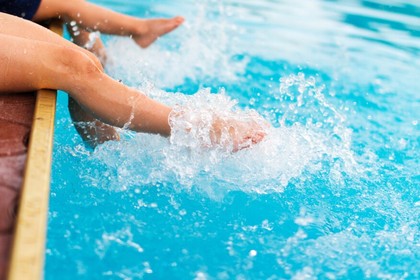Avoiding Pool Chemical-Associated Health Events

Tuesday, May 10, 2022
Pool chemicals treat recreational water to prevent illnesses and outbreaks. These same chemicals, however, can also cause injuries if mishandled or used in an improperly configured commercial sanitization system.
Having a well-configured sanitation system with fail-safe mechanisms can greatly reduce the potential for illness or injury, and these incidents can often be severe. For example, a fleet of ambulances was required to transport more than a dozen swimmers to an area hospital in Southern California after a malfunctioning pump released as much as 10 gallons of chlorine into the pool full of swimmers.
When chlorine gas comes into contact with moist tissues such as the eyes, throat, and lungs, an acid is produced that can damage these tissues (CDC). In a Texas waterpark, a combination of 30-35% sulfuric acid and 10-13% bleach caused “respiratory distress” in the majority of the 65 people affected (Spring Fire Department Chief Scott Seifert).
A Too-Common Theme
Many chlorine gas incidents are linked to a combination of acid and chlorine sanitizers. With sufficient water flow, feeding these two chemicals is an essential part of keeping the pool water healthy. If there is not sufficient water flow to dilute the chemicals, a harmful concentrated chlorine gas cloud can be formed. There should be interlocks to prevent feeding these two chemicals when there is no water flow. However, many systems do not have functioning interlocks or pool operators who know how to test them and ensure they are working properly.
In many jurisdictions, commercial pools are required to be operated with an automated system that feed chemicals on a timed set up and might even alert pool managers when there’s a problem. However, even the top-of-the-line automated chemical feeders can always be compromised.
For example, a power outage – caused by a storm or maintenance elsewhere at the pool – can easily disrupt the system. If the feeder isn’t connected with the filtration system, the power could cause the water to stop being filtered, but the chemicals may continue to flow into the water, creating a surge in toxicity. Even something as simple as someone accidentally turning off the system can cause the issue to occur.
Not only that, in most cases, the chemical surplus isn’t detected until it flows back to the control box, by which time patrons in the pool have already been exposed. At that point, it’s a matter of alerting the patrons to exit as quickly as possible.
How to Prevent Exposure
Fortunately, there are preventable steps that can be taken to avoid chemical overexposure to patrons.
Make sure that the automated feeder is connected to the filtration system so that the two are in sync. If a power outage occurs, both will shut down simultaneously without the feeder continuing to send chemicals without water. Ensure that multiple interlocks are in place to prevent feeding of chemicals when there is insufficient water circulation. Test those interlocks monthly.
Invite manufacturers of equipment to come on-site to train employees at the start of the season, and annually for year-round pools. Ensure that safety equipment, such as gloves and goggles, are available. Place checklists detailing step-by-step processes for managing and maintaining the equipment throughout the season and/or year.
Have staff watch the pool chemical safety video from the American Chemistry Council for further education and understanding of the materials. (https://www.chlorineinstitute.org/stewardship/resources/)
Have pool systems inspected by a qualified pool technician regularly to ensure that systems are operating correctly, and that regular maintenance is being performed.
Store chemicals carefully in well-labeled, well-ventilated spaces. Separate chemicals in different areas to ensure that they are not confused and mixed up. Walk staff through each one and ensure that they are clear which chemical is which.
Make sure patrons are not allowed back in the pool too soon after adding chemicals.
Post pool chemical safety posters in chemical storage and handling areas. Free laminated posters are available from CDC. (https://www.cdc.gov/healthywater/swimming/aquaticsprofessionals/pool-chemical-safety.html)
In Case of Exposure
Should an incident occur, close the pool and call for medical help immediately. For eye or skin burns, swimmers should wash the affected area with fresh water. Those suffering from respiratory exposure should be taken to fresh air.
While maximizing the enjoyment and health benefits of water recreation, pool operators must also minimize the risk for transmission of disease-causing microorganisms and chemical-associated health events. Prevention of these adverse health events should be a core element in risk management. The health and safety of patrons and guests depends upon proper water balance and properly sized and configured sanitation systems. It also depends upon proper operator knowledge plus thorough, frequent inspections and testing of hydro mechanical, electrical, and operational systems, and all supporting equipment.